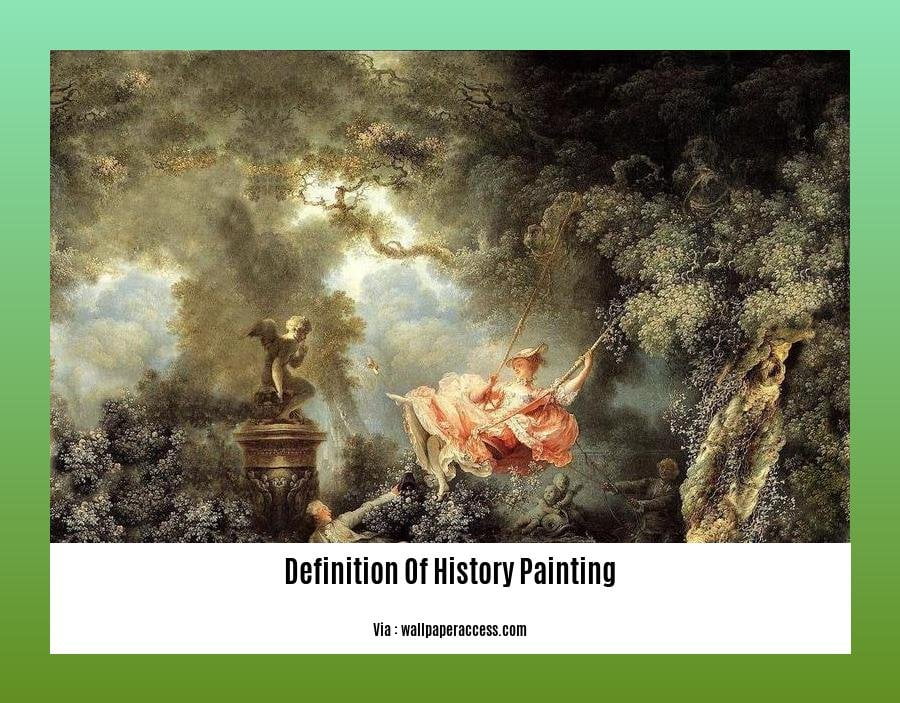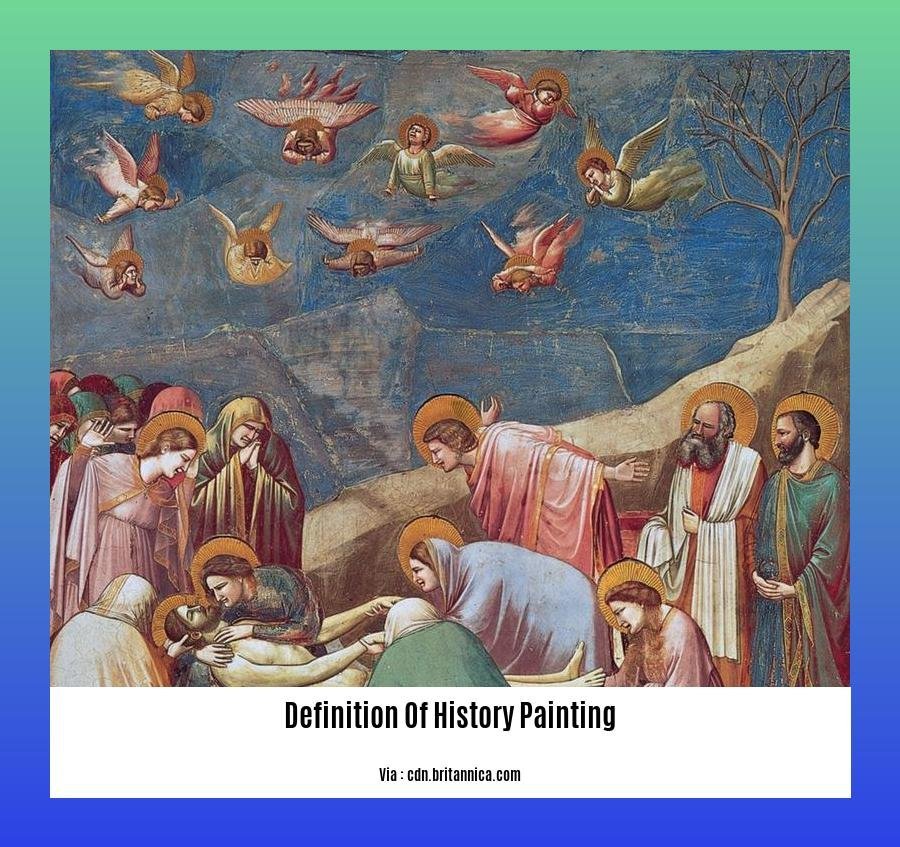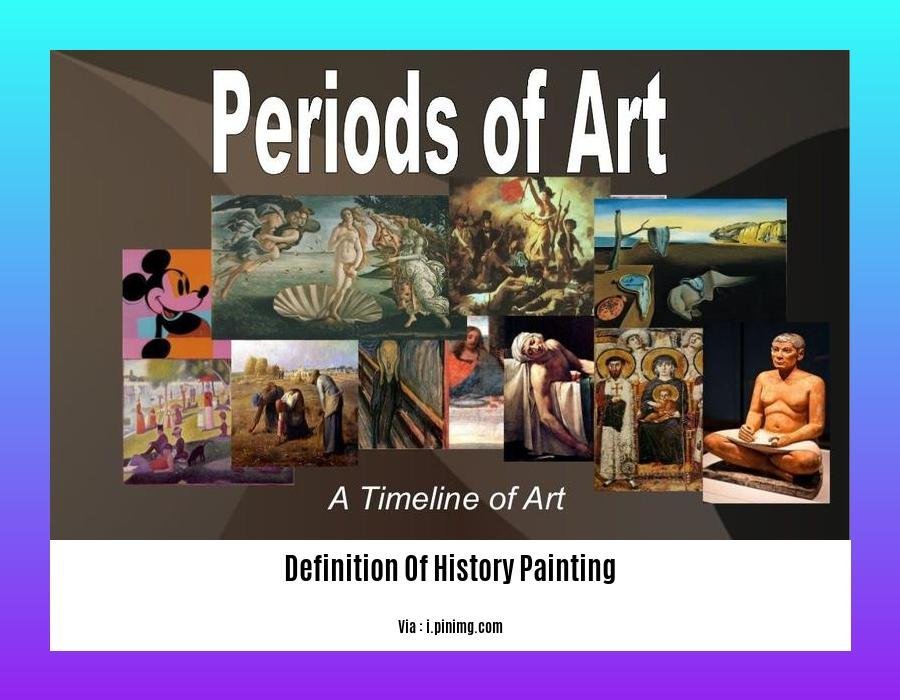[- The Definition of History Painting and Its Role in Shaping Collective Memory]: History painting, a genre that depicts historical events and narratives, has played a pivotal role in shaping collective memory and cultural identity throughout art history. Artists have employed this genre to commemorate significant moments, explore societal values, and critique political ideologies, leaving an indelible mark on the way we perceive and understand our past. Join us as we delve into the captivating world of history painting, uncovering its unique characteristics, symbolic meanings, and enduring impact on art and society.
Key Takeaways:
- History painting is a genre of painting that depicts a moment in a narrative story, usually from Greek and Roman mythology or the Bible.
- History painting had its very own term coined by the French Royal Academy in the 17th century.
- History paintings are generally large in size and complex, featuring numerous figures with intricate backgrounds.
- These paintings are meant to attract viewers visually and convey a message or tell a story.
- “The Last Supper” by Leonardo da Vinci, “The School of Athens” by Raphael, and “The Rape of the Daughters of Leucippus” by Peter Paul Rubens are just a few examples of famous history paintings.
Definition Of History Painting

History painting is a distinct genre of art devoted to portraying past moments, scenes, and events of historical significance or mythological/Biblical narratives. By combining elements of visual storytelling and artistic imagination, artists strive to encapsulate profound moments and communicate rich narratives through these paintings.
Key Characteristics:
Epoch-defining Moments: History paintings capture pivotal moments, typically from ancient history or religious texts, that hold cultural and historical significance.
Storytelling: These paintings tell compelling stories, often with deep emotional impact. The artist’s skill in conveying emotions and expressions plays a crucial role.
Symbolic Motifs: Artists often employ symbols, allegories, and metaphors to convey complex messages and meanings, enriching the narrative.
Technical Proficiency: History paintings showcase the technical expertise and mastery of the artist, demanding high levels of skill in composition, color theory, and perspective.
Emotional Impact: Beyond the story itself, history paintings aim to evoke strong emotions in viewers, drawing them into the depicted moment.
Impact on Collective Memory:
History paintings possess the incredible power to shape and influence our collective memory, forging a bond between the present and the past. They serve as a visual chronicle of significant events, preserving and transmitting knowledge across generations. These paintings also offer perspectives on historical occurrences, shaping our understanding of the past.
Historical Context:
The concept of history painting gained prominence in the 17th century, particularly in European academies. It was considered a noble and esteemed genre, demanding artistic virtuosity and mastery. History paintings often reflected the values and ideals of the time, serving as powerful propaganda tools and instruments of education.
Examples of History Paintings:
Leonardo da Vinci – “The Last Supper”
Caravaggio – “The Crucifixion of Saint Peter”
Jacques-Louis David – “The Death of Marat”
Eugène Delacroix – “Liberty Leading the People”
Pablo Picasso – “Guernica”
History painting is a testament to the transformative power of art in capturing and communicating the essence of significant events and narratives, shaping our understanding of the past and present through the lens of artistry.
Wondering about the definition of history? Explore the captivating journey of how the past has shaped our present and future.
Want to know how historians define history? Dive into the definition of history by historians and gain insights into the diverse perspectives and approaches to understanding the past.
Witness history come alive in the Definition of History Play. Experience an immersive portrayal of historical events and characters through the power of dramatic storytelling.
Examples of History Paintings

History paintings transport us to pivotal moments, capturing the essence of profound events that continue to shape our collective memory. These paintings aren’t just visual records; they’re time capsules, preserving the stories and emotions of bygone eras. Let’s explore some iconic Examples of History Paintings that illustrate this genre’s power:
Key Takeaways:
- History paintings: Capture past moments, scenes, and events with historical, mythological, or biblical significance.
- Leonardo da Vinci’s “The Last Supper”: An iconic depiction of the final meal shared by Jesus and his disciples. Its composition and symbolism convey a powerful message of unity and betrayal.
- Michelangelo’s “The Creation of Adam”: A breathtaking fresco in the Sistine Chapel, it portrays the moment God breathes life into Adam. The detailed hands, reaching towards each other, symbolize the divine spark that connects humanity to its creator.
- Caravaggio’s “The Crucifixion of Saint Peter”: A powerful depiction of the martyrdom of Saint Peter, crucified upside down. The dramatic lighting and raw emotion create a visceral, emotional impact.
- Eugene Delacroix’s “Liberty Leading the People”: An allegorical painting commemorating the July Revolution of 1830. The personification of Liberty, triumphant and fierce, leads the charge forward, inspiring a sense of hope and revolution.
- Pablo Picasso’s “Guernica”: A haunting depiction of the horrors of war, inspired by the bombing of the Basque town of Guernica during the Spanish Civil War. Its fragmented forms and distorted figures convey the chaos and suffering of war.
These Examples of History Paintings offer a glimpse into the profound impact this genre has on shaping our understanding of the past. They remind us that art has the power to transcend time, bridging the gap between generations and preserving the stories that matter.
[Sources]
– https://en.wikipedia.org/wiki/History_painting
–
Relevance and Significance of History Painting
Visualizing Historical Narratives: History painting, a genre of art that captures significant moments from our past, plays a vital role in shaping collective memory. These paintings, often dramatic and emotive, transport viewers to another time and place, providing a glimpse into pivotal events, cultural practices, and social dynamics of bygone eras.
The Significance of History Painting
1. Preserving Historical Legacy:
- Timeless Records: History paintings serve as enduring records of the past, capturing moments that might otherwise be lost to time.
- Visual Archives: They offer a visual archive of past events, allowing future generations to understand and appreciate historical narratives.
2. Unveiling Cultural Values:
- Reflections of Society: History paintings reveal the values, beliefs, and aspirations of the cultures in which they were created.
- Cultural Mirrors: They mirror societal norms, political ideologies, and religious sentiments, providing insights into past mindsets.
3. Inspiring Patriotism and Identity:
- National Pride: History paintings instill a sense of national pride and identity by glorifying patriotic moments and heroic figures.
- Unifying Force: They serve as rallying points, fostering unity and shared historical consciousness within societies.
Key Takeaways:
- History paintings: Offer visual representations of historical, mythological, or Biblical events.
- Historical Significance: Serve as enduring records of the past, preserving cultural heritage.
- Cultural Reflections: Reveal societal values, beliefs, and aspirations of the time they were created.
- Emotional Impact: Evoke strong emotions, drawing viewers into the depicted events.
- Narrative Storytelling: Capture pivotal moments, using visual elements to convey complex stories.
- Prestige and Status: Highly regarded genre in the art world, often commissioned by wealthy patrons.
Relevant URL Sources:
History Painting – Wikipedia
History painting | Tate
FAQ
Q1: What is the definition of history painting?
A1: History painting is a genre of painting that portrays a significant moment in a historical, religious, mythical, or fictional narrative involving multiple figures. This genre emphasizes storytelling and the depiction of important events or actions that carry historical, moral, or allegorical significance.
Q2: What historical period did history painting gain popularity?
A2: History painting gained popularity during the mid-15th century and continued to be a prominent genre until the 19th century. It experienced a surge in the 17th century, where it was considered the most prestigious genre in painting, surpassing portraiture and other forms of painting.
Q3: What is the significance of history painting?
A3: History painting holds significant importance as it serves multiple purposes. It glorifies historical figures and events, conveys moral and ethical lessons, instills patriotism, and provides a visual representation of societal values and cultural narratives. Additionally, it contributes to the preservation and collective memory of historical events, myths, and stories.
Q4: What challenges did artists face when creating history paintings?
A4: Artists creating history paintings encountered several challenges. They needed extensive research and knowledge of historical events, figures, and costumes to accurately depict the subject matter. Moreover, they had to compose visually engaging compositions that effectively communicated the narrative of the painting. Additionally, they had to consider the scale and complexity of the painting, as history paintings were often large and involved multiple figures and intricate details.
Q5: Can you provide some examples of famous history paintings?
A5: Notable examples of history paintings include “The Last Supper” by Leonardo da Vinci, depicting the final meal of Jesus with his disciples; “The School of Athens” by Raphael, portraying a gathering of philosophers and scholars in ancient Greece; and “The Oath of the Horatii” by Jacques-Louis David, depicting three brothers pledging their allegiance to defend Rome. These paintings exemplify the skill, artistry, and storytelling abilities of history painters throughout art history.
- Star Ring Trends: Etsy vs Amazon - March 28, 2025
- Boost Pollinator Habitats: Baby Blue Eyes Sustainable Farming Guide - March 28, 2025
- Protect Big Black Bears: Effective Conservation Strategies - March 28, 2025
















